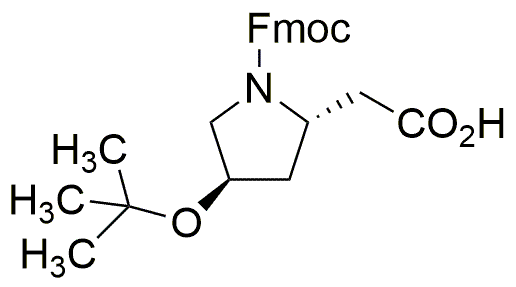Fmoc-O-tert-butyl-L-b-homohydroxyproline is widely utilized in research focused on:
- Peptide Synthesis: This compound serves as a key building block in the synthesis of peptides, particularly in solid-phase peptide synthesis (SPPS), allowing for the creation of complex peptide structures with high purity and yield.
- Drug Development: It plays a significant role in the pharmaceutical industry for developing new drugs, especially those targeting specific biological pathways, due to its ability to modify peptide sequences effectively.
- Bioconjugation: The compound is used in bioconjugation processes, which involve attaching biomolecules to other molecules, enhancing the efficacy of therapeutic agents and improving drug delivery systems.
- Research in Protein Engineering: Researchers utilize this chemical in protein engineering to create novel proteins with desired properties, aiding in the development of new biocatalysts and therapeutic proteins.
- Cosmetic Formulations: Its application extends to the cosmetic industry, where it is used in formulations aimed at improving skin hydration and texture, leveraging its biochemical properties for enhanced skin benefits.
General Information
Properties
Safety and Regulations
Applications
Fmoc-O-tert-butyl-L-b-homohydroxyproline is widely utilized in research focused on:
- Peptide Synthesis: This compound serves as a key building block in the synthesis of peptides, particularly in solid-phase peptide synthesis (SPPS), allowing for the creation of complex peptide structures with high purity and yield.
- Drug Development: It plays a significant role in the pharmaceutical industry for developing new drugs, especially those targeting specific biological pathways, due to its ability to modify peptide sequences effectively.
- Bioconjugation: The compound is used in bioconjugation processes, which involve attaching biomolecules to other molecules, enhancing the efficacy of therapeutic agents and improving drug delivery systems.
- Research in Protein Engineering: Researchers utilize this chemical in protein engineering to create novel proteins with desired properties, aiding in the development of new biocatalysts and therapeutic proteins.
- Cosmetic Formulations: Its application extends to the cosmetic industry, where it is used in formulations aimed at improving skin hydration and texture, leveraging its biochemical properties for enhanced skin benefits.
Documents
Safety Data Sheets (SDS)
The SDS provides comprehensive safety information on handling, storage, and disposal of the product.
Product Specification (PS)
The PS provides a comprehensive breakdown of the product’s properties, including chemical composition, physical state, purity, and storage requirements. It also details acceptable quality ranges and the product's intended applications.
Certificates of Analysis (COA)
Search for Certificates of Analysis (COA) by entering the products Lot Number. Lot and Batch Numbers can be found on a product’s label following the words ‘Lot’ or ‘Batch’.
Número de catálogo
Número de lote/lote
Certificates Of Origin (COO)
This COO confirms the country where the product was manufactured, and also details the materials and components used in it and whether it is derived from natural, synthetic, or other specific sources. This certificate may be required for customs, trade, and regulatory compliance.
Número de catálogo
Número de lote/lote
Safety Data Sheets (SDS)
The SDS provides comprehensive safety information on handling, storage, and disposal of the product.
DownloadProduct Specification (PS)
The PS provides a comprehensive breakdown of the product’s properties, including chemical composition, physical state, purity, and storage requirements. It also details acceptable quality ranges and the product's intended applications.
DownloadCertificates of Analysis (COA)
Search for Certificates of Analysis (COA) by entering the products Lot Number. Lot and Batch Numbers can be found on a product’s label following the words ‘Lot’ or ‘Batch’.
Número de catálogo
Número de lote/lote
Certificates Of Origin (COO)
This COO confirms the country where the product was manufactured, and also details the materials and components used in it and whether it is derived from natural, synthetic, or other specific sources. This certificate may be required for customs, trade, and regulatory compliance.


